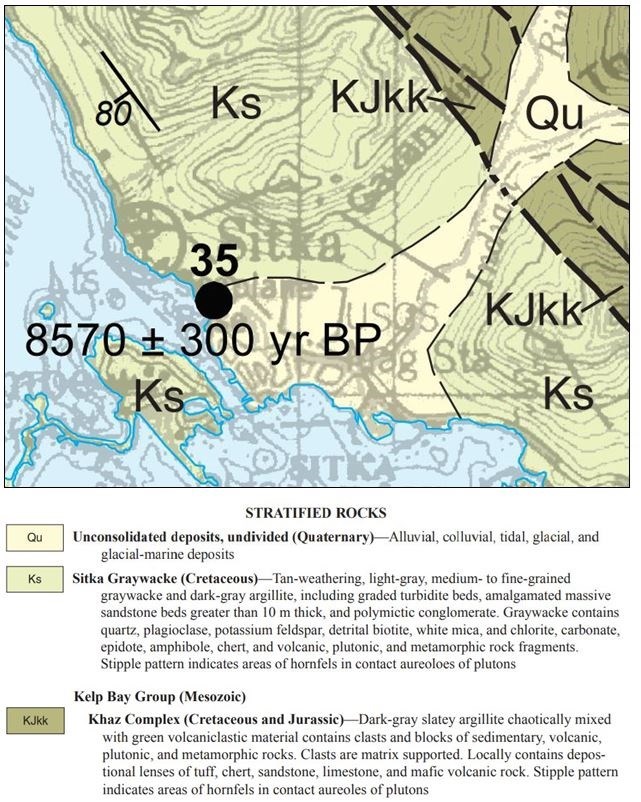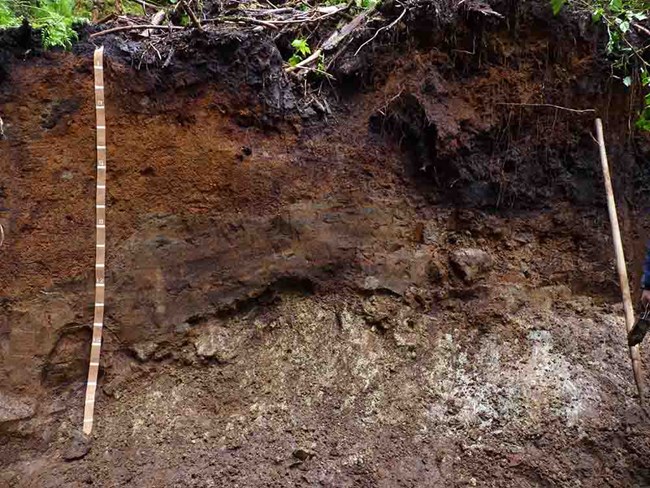
Located along the southeastern shores of Alaska, Sitka’s terrain is a result of intense glacial advances and retreats during the late Pleistocene, about 14,000 to 10,000 years ago. Glaciers carved almost all the land’s features, including deep, narrow bays, steep valley walls with exposed bedrock, thin moraine deposits on hills and in valleys, jagged coastlines, high sea cliffs, and deeply dissected glacial moraine deposits covering the lower slopes of valley walls. In addition to glaciation, other natural forces that shaped the park landscape include plate tectonics, local sea level rise---and fall, river dynamics and delta development, and volcanic activity. For more information, see the geologic map prepared by the U.S. Geologic Survey and the National Park Service geologic resources inventory. Coastal and Marine FeaturesNearly half of the resources at Sitka National Historical Park are coastal or marine, including about a mile of shoreline. Sitka contains 50 acres (20 hectares) of intertidal zone comprised of gravel, cobble, and sand beaches and is a dynamic and complex physical environment. Constant wave action and tides (with a range of 11 feet [3.7 m]) play the biggest role in altering the coast’s exposed geology. Glacial Features—Isostatic ReboundGlaciers advanced across the land that is now Sitka in the Pleistocene Epoch and receded starting around 13,000 years ago. As glaciers melt and recede, the ground rebounds upward in response to the reduction in ice weight; this is called isostatic uplift or isostatic rebound. Isostatic uplift can alter sea levels and may cause increases in erosion. The world’s fastest present-day glacio-isostatic uplift yet documented, 32 mm/year, is measured in Southeast Alaska in the area between Yakutat and Glacier Bay. In comparison, the rate of uplift at Sitka National History Park is about 3 mm/year. The combination of isostatic, tectonic, and volcanic forces has raised the area around Sitka around 10.7 m since deglaciation. Check out local sea-level change in the past and projected sea-level change by using the US Army Corps of Engineers calculator. In addition to isostatic rebound, features that illustrate the park’s glacial past include glacial till, glacially deposited gravels in the intertidal zone, and glacial erratics exposed at low tide.
Fluvial Features—Indian RiverThe Indian River delta was uplifted about 9,000 years ago and now rests above sea level. As with most rivers and streams, the concentrated surficial geology of the Indian River delta consists primarily of flood plain alluvium created through fluvial processes. Outcrops of bedrock are rare; the park primarily rests on sediments carried in by the Indian River. However, there is one such outcrop in the northwest corner of the park. Tectonic and Seismic FeaturesSitka National Historical Park lies approximately 32 km (20 mi) away from the Fairweather-Queen Charolette Fault system, referred to as a “transform fault zone.” This fault system marks the eastern boundary of the Pacific plate and the western boundary of the North American plate. The park lies on the continental North American plate. The Pacific plate moves in a northwestward direction relative to the North American plate, creating a transform boundary, the name given to the interface between two plates moving horizontally in opposite directions. The fault associated with a transform boundary is a strike-slip fault, in this case with right-lateral movement. Recent seismic activity in the region is concentrated along the fault system and occurs almost exclusively in large earthquakes, that is, very few small-magnitude earthquakes occur between large-magnitude events. Recent large-magnitude earthquakes include 1927 in the northern part of Chichagof Island (M 7.1), 1949 along the Queen Charlotte fault near the Queen Charlotte Islands (M 8.1), 1958 along Fairweather fault near Lituya Bay (M 7.9), and 1972 near Sitka (M 7.4). 
Volcanic FeaturesMount Edgecumbe (3,202 ft or 976 m) is located on southern Kruzof Island, which bounds Sitka Sound to the west, is the highest peak in a range of dormant volcanoes. The volcanic field became active about 611,000 years ago and peaked in activity in the Pleistocene, about 11,250 years ago. Ash from this period blanketed all of Sitka and reached to Juneau. The most recent eruptions were about 4,000 years ago and were more limited in impact. 
Bedrock and SoilsBedrock underlying the Sitka area is comprised of greywacke with interbedded argillite that was formed in the Jurassic to Cretaceous periods (180-140 million years ago) and intruded in the Neogene to Cretaceous periods to produce dikes of fine-grained igneous rock. Unconsolidated materials within the park are modern beach or elevated shore and deltaic material deposited in the Holocene Epoch. In the upgradient areas of the park, there are a few discontinuous layers of volcanic ash overlying the glacial drift. |
Last updated: November 10, 2021
